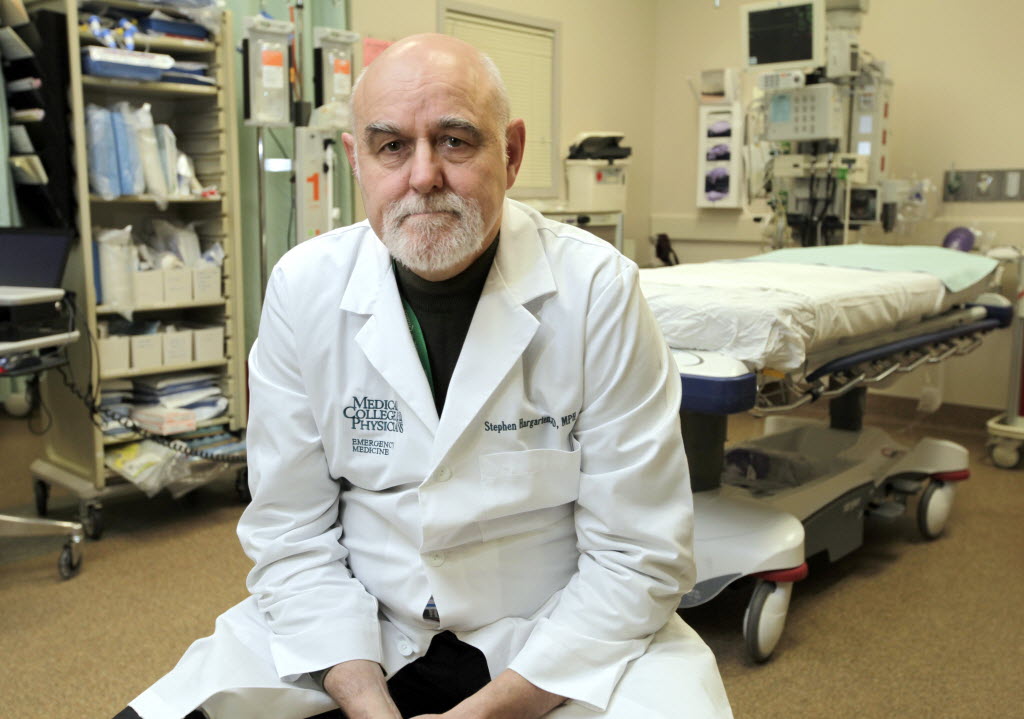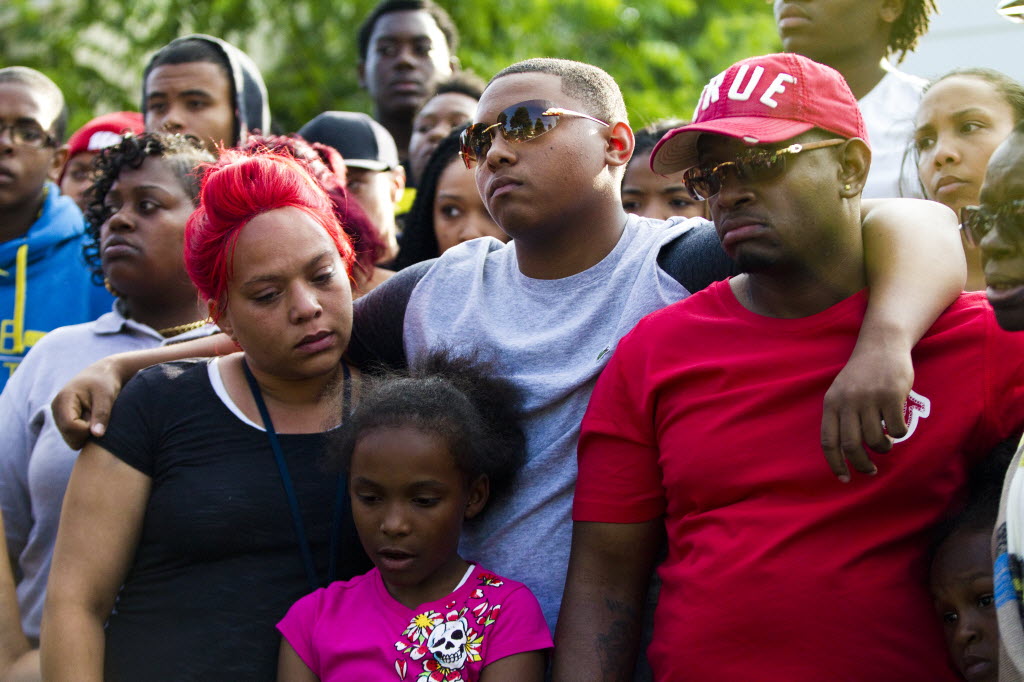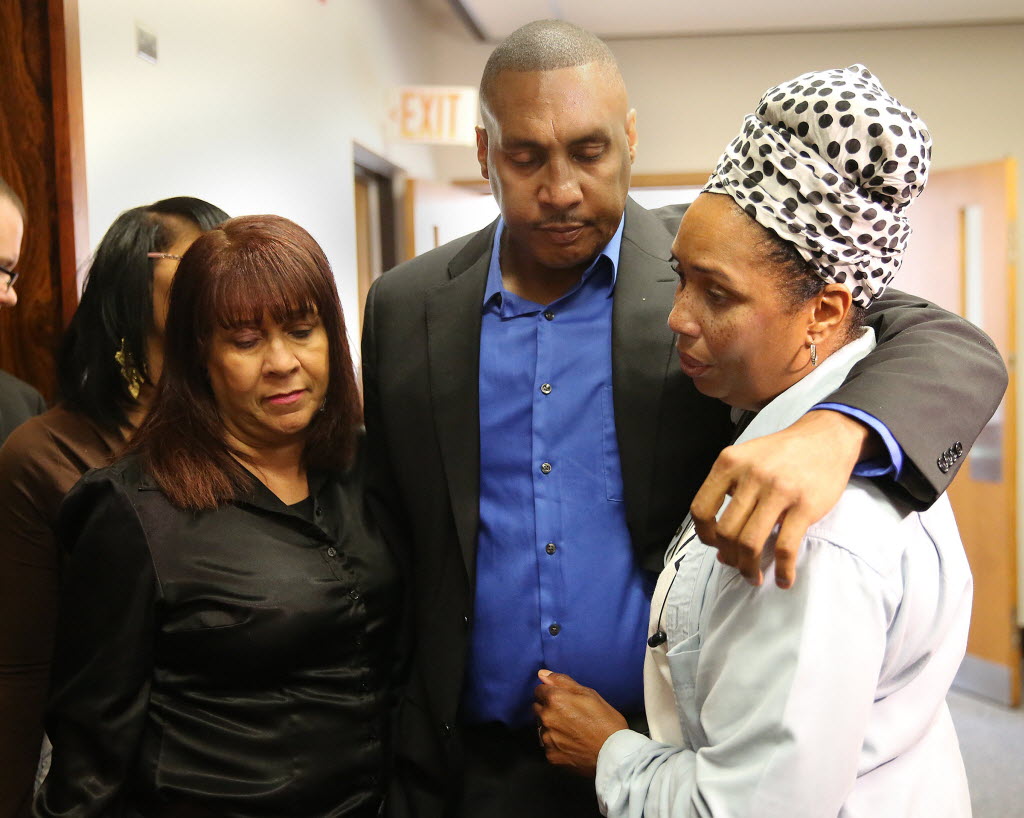The Soaring Cost of Gun Violence
Estimated annual cost in Wisconsin is $2.9 billion, or $508 per person.
Gun violence drives up medical costs
The medical costs of shootings are often borne by taxpayers. Those costs usually begin with a trip to the hospital from the scene of the shooting.
Last year, paramedics from the Milwaukee Fire Department provided services to 297 shooting victims. The average cost was $1,300 per patient, or roughly $386,100.
Statewide, there were 349 hospitalizations and 742 emergency department visits because of firearm-related injuries in 2014, according to Department of Health Services data.
About half of emergency visits and 60 percent of hospitalizations are covered by Medicaid or Medicare, which are public insurance programs. The total amount public insurance programs paid for gun-related injuries in 2014 was about $6 million after negotiations between health care providers and the state and physician fees are factored in.
The Wisconsin Hospital Association, which provided information to the Wisconsin Center for Investigative Journalism used to reach this estimate, cautioned that it is “very rough.”
Dr. Stephen Hargarten, chair of the Department of Emergency Medicine at the Medical College of Wisconsin, said firearm injuries are “very, very expensive” to the public. Unlike knives and other methods of assault, firearms are more deadly and can leave significant long-term disabilities, he said.

Stephen Hargarten, director of the Injury Research Center at the Medical College of Wisconsin
in Milwaukee, said firearm injuries are “very, very expensive” to the public. Photo by Mike De Sisti of the Milwaukee Journal Sentinel.
“It’s costly to all of us because a significant portion of the people who are injured with bullets are those who are on Medicaid, Medicare or self pay,” said Hargarten, director of the college’s Injury Research Center.
Ted Miller, senior research scientist at the nonprofit Pacific Institute for Research and Evaluation, said there may be additional costs for mental health care for those impacted by violence. Miller is is an expert in the costs of gun violence and other injuries at the institute, which uses research to recommend ways to improve public safety and health. For every type of homicide, he said, somewhere between 1.5 and 2.4 family members and loved ones of the victims seek mental health care.
Often, those costs, which vary from person to person, also are covered through public insurance programs, said Dr. Marlene Melzer-Lange, a professor of pediatrics at the Medical College of Wisconsin and program director of Project Ujima at the Children’s Hospital of Wisconsin in Milwaukee. Project Ujima provides mental health services to both adults and child victims of violent crime.
A small percentage of shootings leave victims paralyzed or gravely injured. That can lead to being placed on the state’s long-term care programs, which cost taxpayers roughly $3,100 a month for nursing home care or $530 a month for in-home care.
Legal, law enforcement costs high
Another cost is police response. That can vary significantly, from sending two officers to a report of shots fired to shutting down several blocks as officers canvass an area looking for evidence in a homicide. The time it takes to conduct an investigation depends on the cooperation of victims and witnesses and other factors.
“It’s different for every shooting,” said Milwaukee Police Department Sgt. Tim Gauerke. “Every one of them is based on the circumstances on hand.”
In 2014, the department dispatched units to 6,622 reported calls of shots fired — an average of 18 calls a day. Those calls may have overlapped with the 3,632 incidents of gunshots detected by the department’s ShotSpotter detection system, which allows police to pinpoint locations where a firearm has been discharged in an area of 11 square miles in the city.
That system expanded last year with a one-time funding of $350,000 split by the state and Milwaukee, and now costs the city more than $320,000 a year.
Wisconsin’s largest city has the most homicides and nonfatal shootings in the state. According to the Milwaukee Homicide Review Commission, there were 75 firearm homicides and 583 nonfatal shooting victims in the city in 2014. The Milwaukee County District Attorney’s Office prosecuted more than 1,100 cases involving a firearm last year.
To support efforts this year, the state, the city of Milwaukee and Milwaukee County formed the Milwaukee Gun Violence Reduction Initiative. The Legislature’s budget-writing committee unanimously backed $366,800 for the state to hire two assistant attorneys general to work as special prosecutors for gun cases in Milwaukee. Democratic and Republican lawmakers called the program a “Band-Aid” solution.

(From left) Arifah Akbar, Nazir Akbar and Katraile Scott stand together during a vigil for Tariq Akbar, on July 7. Tariq was shot to death July 3 in Milwaukee after watching a fireworks display with his friends. This year, Milwaukee has seen a sharp increase in shootings, which can cost taxpayers and victims tens if not hundreds of thousands of dollars each in medical bills, incarceration costs and other expenses. Photo by Katie Klann of the Milwaukee Journal Sentinel.
On the other side of firearm-related cases, the State Public Defender’s Office provides legal representation to defendants who cannot afford an attorney.
Since 2012, the office has appointed private attorneys to represent defendants in 832 armed robbery cases, paying each an average of $1,415. (Armed robbery can include any type of weapon, including a gun.) That amounts to $1.2 million and does not include the cost of paying public defender staff who represented other armed robbery suspects.
After they are convicted, inmates cost Wisconsin taxpayers an average of $32,800 a year. The average cost to supervise an offender after release is about $2,800 annually.
Police caught King, the teenager who shot Motley, shortly after the June 21, 2014, after he committed another crime. In that incident, King attempted to steal a woman’s car. She pulled out a gun and shot him, leaving King paralyzed from the waist down.
Motley fought to ensure King was tried as an adult because he felt a sentence in the juvenile system would have been too light.

Claudiare Motley is surrounded by his sisters after the sentencing of Nathan King in July. Motley, who was shot in Milwaukee last year, has undergone multiple surgeries and faced tens of thousands of dollars in bills and lost wages. Motley was one of 583 victims of nonfatal shootings in Milwaukee in 2014. Photo by John Klein for the Milwaukee Journal Sentinel.
“I just felt that was not enough to teach a lesson to a person who was really violent,” he said.
Gun violence costs wide-ranging
It is not just victims and perpetrators who pay a high price. There are other costs — some of them hard to quantify.
“We don’t know some of the other less easily defined costs of the fact that people in rural areas won’t come to Milwaukee because they’re scared,” said Hargarten of the Medical College of Wisconsin. “There’s an impact on tourism. There’s an impact maybe on businesses trying to locate somewhere else because the perception is that Milwaukee is not very safe.”
Miller said another understudied cost is the impact of adverse childhood experiences — serious traumas, such as witnessing or being a victim of gun violence. Studies show those experiences can harm brain development and may increase future health problems, including heart disease, depression and drug abuse.
“I think a lot of us for a long time have said violence is a public health problem, and a lot of people didn’t really believe it,” said Melzer-Lange of Project Ujima. “Your health either as a witness or as a direct victim is going to be affected downstream.”

Dr. Marlene Melzer-Lange, a professor of pediatrics at the Medical College of Wisconsin and program director of Project Ujima at the Children’s Hospital of Wisconsin in Milwaukee, said children who witness violence are more likely to suffer future health problems. Photo courtesy of the Children’s Hospital of Wisconsin.
Schools also pay for gun violence. According to a 2013 article in the trade magazine Campus Safety, 88 percent of school districts nationwide made or planned to make security enhancements after the Sandy Hook Elementary School mass shooting in 2012.
There is also the “value of a statistical life.” Economists calculate that number by summing up what people are willing to pay for a small reduction in the probability of death. For example, if each person living in a community of 100,000 would pay $100 to reduce the number of deaths by one each year, the value of life would be $10 million.
The U.S. Department of Transportation puts the value at $9.4 million. This value is used nationwide by the department to analyze whether the cost of a certain potentially life-saving regulation or transportation improvement is worthwhile.
Miller puts the statistical value for one person injured by gun violence at $6.2 million. He said that “accounts for the pain, suffering and the lost quality of life for victims and their families.”
Victims can get some of their costs covered. Wisconsin’s Crime Victim Compensation Program caps the amount victims and their families can receive at $40,000 and only for out-of-pocket expenses. Qualifying families can also receive up to $1,000 to clean up a crime scene and $2,000 for a funeral. In all, $4.1 million was awarded in 2013-14 for 2,498 claims. The average claim paid was $3,205.
What can be done to curb violence?
Reducing gun violence requires a multi-faceted approach, experts say, with policy initiatives at the federal, state and local levels.
“If we can make those cities safer for gun violence, then they can develop and become places that thrive economically where businesses are investing in them, where employment becomes generally available,” said Cook of Duke.
Wisconsin lawmakers have offered some solutions. Gov. Scott Walker recently signed into law a bill that establishes mandatory minimum sentences for felons who commit certain violent crimes while illegally possessing a firearm.

Phil Cook, a professor of public policy, economics and sociology at Duke University, said gun violence is costly to the entire community. “It’s a drag on economic development, it’s a drag on quality of life in a variety of ways,” he said. Photo courtesy of Duke University.
State Democrats want to expand background checks for firearm purchases and ban semiautomatic weapons. A bill with bipartisan support would prevent those who commit multiple or violent misdemeanors from purchasing a firearm for 10 years, but those bills have not moved far in the Legislature.
During a Nov. 4 discussion before voting to pay for additional prosecutors for Milwaukee gun crimes, Democrats called for more action.
“Until we get to the bottom of addressing trauma and giving people hope by giving people opportunity through jobs, nothing’s going to change,” said Sen. Lena Taylor, D-Milwaukee.
Twenty-four Democratic U.S. senators and 114 House members are urging President Barack Obama to use his executive powers to require universal background checks nationally.
State Republican lawmakers during the committee discussion saw different answers to the gun violence problem.
State Rep. Dale Kooyenga, R-Brookfield, said the problem needs to be addressed on multiple fronts. The state already has “a lot of gun laws,” and he said some of the issues may not be solvable through public policy.
Sen. Alberta Darling, R-River Hills, called for more police officers and getting “habitual criminals” off the streets.
Motley agreed in part. He said repeat offenders, such as the 17-year-old who gave King the gun used to shoot him are part of “an epidemic that’s going on in the system.” Motley wants to find a way to prevent shootings and get guns off the streets, a focus that helps relieve some of the anger he feels at what happened to him.
“I’m not going to lay down. That’s not who I am,” Motley said. “And I’m just going to keep fighting.”
Ashley Luthern of the Milwaukee Journal Sentinel and Kate Golden of the Wisconsin Center for Investigative Journalism contributed to this report.
This report was produced in collaboration with Precious Lives, a two-year project investigating the problem of gun violence among young people, its causes and potential solutions in the Milwaukee area and statewide. Other partners in the project are 371 Productions, the Milwaukee Journal Sentinel, Milwaukee Public Radio 89.7 WUWM and The Voice 860 AM WNOV.
The Wisconsin Center for Investigative Journalism’s (www.WisconsinWatch.org) coverage is supported by The Joyce Foundation.
The nonprofit Center collaborates with Wisconsin Public Radio, Wisconsin Public Television, other news media and the UW-Madison School of Journalism and Mass Communication. All works created, published, posted or disseminated by the Center do not necessarily reflect the views or opinions of UW-Madison or any of its affiliates.
Article Continues - Pages: 1 2
-
Legislators Agree on Postpartum Medicaid Expansion
 Jan 22nd, 2025 by Hallie Claflin
Jan 22nd, 2025 by Hallie Claflin
-
Inferior Care Feared As Counties Privatize Nursing Homes
 Dec 15th, 2024 by Addie Costello
Dec 15th, 2024 by Addie Costello
-
Wisconsin Lacks Clear System for Tracking Police Caught Lying
 May 9th, 2024 by Jacob Resneck
May 9th, 2024 by Jacob Resneck






















It’s time to have a special sales tax on weapons and ammo to fund public safety and health care for victims. Also, the Supreme Court has refused to review a ban on assault weapons and high capacity magazines so it’s time to move forward on this front. Hunters are only allowed a certain amount of rounds in their weapons. They don’t need high capacity clips/magazines. AND the absurd notion that somehow or other “I” will ever need a high capacity magazine for protection needs to be challenged. Lastly, as a combat veteran of Vietnam (just a grunt) I wonder how many folks ever know how they will react when shot at? It’s a whole lot different than movies or macho strutting. It’s all about managing fear and learning how to do that. I would imagine even cops find themselves terrified in such situations and needing to learn. Let’s give up the notion that “the only thing that stops a bad guy with a gun is a good guy with a gun” as a reason for arming everybody. Note the situation in Neenah where the cops got it wrong, it seems, and shot a hostage who was a good guy with a gun? peace, tw
It’s ironic you you feel that way, tomw… because Nathan King, the boy who shot Claudiare, was eventually stopped by a ccw permit holder when King tried to rob her as well.
How about we hold parents accountable for their childrens actions… or at least for letting them run the streets at 1:30 am. Or how about we try to promote traditional family values and education. It’s no surprise that Nathan King came from a single parent household. Where are the fathers in all this?
How about we rescind this ludicrous no chase policy in Milwaukee? Nathan King and his crew stole car after car and used them in multiple violent crimes. By not chasing “non-violent” car thieves the criminals are free to use those stolen cars in many other crimes.
Motley is right, Milwaukee has a “cultural acceptance of violence” and a “proliferation of guns and illegal drugs.” We need families that support their children, improve enducation, and provide opportunities. Not create a tax on law abiding citizens who have no relationship to this violence.
And Ed Flynn says part of the gun problem is the state’s concealed carry law, but what does he know? He’s only the police chief.
I’m all for holding parents accountable. Too many times they aren’t charged when one of their guns is used in a shooting, accidental or otherwise, and that’s absurd.